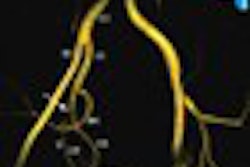Researchers at Loma Linda University Medical Center in Loma Linda, CA, and Thomas Jefferson University Hospitals in Philadelphia have found that noncontrast MRI of the shoulder is an effective way to diagnose adhesive capsulitis.
The study also offers several other findings to increase the confidence in an adhesive capsulitis diagnosis. Lead author Dr. John Kim from Loma Linda presented the findings at the American Roentgen Ray Society (ARRS) annual meeting in Boston.
Adhesive capsulitis, also known as frozen shoulder, can be defined as inflammation of the shoulder capsule, which likely presents with slow onset of pain and restriction in both passive and active range of motion. The condition is prevalent in 2% to 3% of the general population, mainly among people 40 to 70 years of age, with females experiencing the condition more often than men.
While both surgical and conservative treatments can be effective, noncontrast MRI is less invasive than MR arthrography and may be the preferred option for patients who are between 40 and 70 years and are not candidates for MR arthrography.
Patient sample
Sixteen patients (10 women and six men) with suspected adhesive capsulitis who had received noncontrast MRI scans of their shoulders were selected for the study. The patients ranged in age from 38 to 72 years, with a mean age of 56 years. The researchers also assembled a control group of 15 patients of similar age and sex who received MRI exams without clinically suspected adhesive capsulitis.
Standardized noncontrast MRI protocol was performed on a 1.5-tesla system (Magnetom Sonata, Siemens Healthcare, Malvern PA). The cases were randomized and presented to a musculoskeletal-trained radiologist, who conducted qualitative and quantitative evaluations, checking for coracohumeral ligament (CHL) thickening, obliteration of the subcoracoid fat, and edema at the axillary recess. The reader also rated the confidence level of diagnoses from one to five and noted any additional findings.
The researchers proposed several findings for the diagnosis of adhesive capsulitis on noncontrast MRI: thickening of the coracohumeral ligament greater than 2 mm, subcoracoid fatty infiltration, and inferior glenoid injury or thickening of the joint capsule in the axillary recess. Hence, sensitivity and specificity were calculated for adhesive capsulitis diagnosis by CHL thickening alone, axillary edema alone, sucoracoid triangle infiltration, and other factors.
Analyses and results
The quantitative analysis of the CHL thickening demonstrated a mean value of 3.6 mm in patients clinically suspected of adhesive capsulitis, compared with 2.8 mm in the control group with no clinical suspicion of adhesive capsulitis.
"That was found to be statistically significant," Kim said. "Using coracohumeral ligament thickness as a sole criterion, increasing the threshold volume from 3 mm to 4 mm increases the specificity but decreases the sensitivity. At 4 mm, we have specificity of 80% and sensitivity of 40%."
The researchers also found that qualitative analysis demonstrated no statistical significance when comparing the findings of patients with adhesive capsulitis versus the control group. The study, however, did find an increase in the number of patients with axillary edemas and rotator cuff disease.
In the diagnostic review of patients, specificity was 87% and sensitivity was 47% for axillary edema, with varying diagnostic values for subcoracoid triangle, depending on the degree of infiltration.
Rotator cuff factor
"There was a slight increase in the number of patients with rotator cuff disease in patients with adhesive capsulitis," Kim noted. "There may be a possible relationship of adhesive capsulitis with rotator cuff disease, but further investigation is needed."
For patients who met the MRI criteria for adhesive capsulitis but were not clinically suspected to have the condition, the radiologist's average confidence level was 3.25, with five as the highest rating, compared with an overall average of 3.5.
Limitations of the study included the small number of patients in the sample, and only one reviewer has looked at the images thus far. Analysis from a second viewer is pending. Also, there was no surgical or arthrographic correlation obtained to compare results.
With the data obtained, Kim said the study concluded that "clinical adhesive capsulitis can be reliably predicted with noncontrast MRI, coracohumeral ligament is thicker in patients suspected of adhesive capsulitis, and axillary recess edema on noncontrast MRI is the best sole criteria for diagnosis."
While the study proposes ways to make a diagnosis of adhesive capsulitis with more confidence, the researchers wrote that "further investigation will be conducted to refine the criteria to achieve even greater concordance of radiographic and clinical diagnoses of adhesive capsulitis."
By Wayne Forrest
AuntMinnie.com staff writer
June 3, 2009
Related Reading
MR arthrography study finds 'optimal injection site', October 24, 2008
Making the most of MRI to assess the rotator cuff pre- and postinjury, November 9, 2007
MRI keeps pace with rapidly evolving musculoskeletal systems of young athletes, May 20, 2007
MR arthrography depicts tears, instability in triangular fibrocartilage complex, January 19, 2007
MR arthrography typifies cam and pincer FAI for intracapsular hip surgery, August 22, 2006
Copyright © 2009 AuntMinnie.com


.fFmgij6Hin.png?auto=compress%2Cformat&fit=crop&h=100&q=70&w=100)





.fFmgij6Hin.png?auto=compress%2Cformat&fit=crop&h=167&q=70&w=250)











